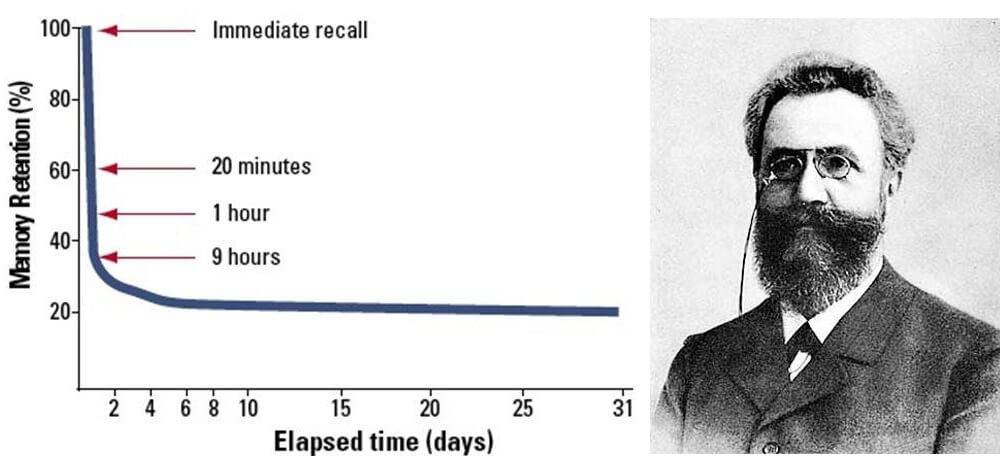
All too often training is being delivered in a way that simply doesn’t work for the learner. We have known this for a long time but we have now found an innovative and effective solution.
Hermann Ebbinghaus was a German psychologist who pioneered the experimental study of memory, and is known for his discovery of the ‘forgetting curve’. He asked subjects to memorise a list of meaningless, three letter words and then tracked how quickly they forgot them. He then graphed this into the ‘forgetting curve’.

The research demonstrated that only approximately 20% of information is likely to be retained after a week. Further research demonstrated that retention rates are between 8 and 15% with traditional teaching methods. He also said the three primary factors on how well information is retained are:
1.Repetition
2.Meaningful content
3.Optimal learning environment
Learner involvement and the use of a practical component was also recognised as important. Benjamin Franklin famously quoted “Tell and I forget, teach me and I remember, involve me and I learn’.
As much of today’s training is developed by people who learn well from written material however it is important to understand that people learn in different ways. Today, the generation joining the workforce learn in a way inconceivable to Ebbinghaus, and we must deliver key messages to workers in a way that enables them to retain this information.
Traditionally, a document to explain something remains a popular approach, useful to explain ideas and give background understanding. Historically in New Zealand, we produced detailed booklets and manuals which provide large amounts of technical data. Its greatest strength is that it creates an authoritative document. It is useful when evidence is required. It is easily read and understood by people with an affinity for technical detail. Written communication provides all the information to everyone, even if it’s not quite what they need or understand, and few publications are set up well enough to be able to focus on the information needed. It can be time-consuming hunting through for what you want to know.
Preparing such material is expensive and often is only correct at the time it is written, quickly becoming out of date.
Such documents tend to be full of esoteric language, making it useless if the reader doesn’t understand the jargon. Learners often struggle with the written word.
To improve on this, Standard Operating Procedures or SOPs are seen by many as the answer to large complex manuals. SOPs done well, using a clear format, can be much easier to read and increasingly companies have used photos make them easier to understand. They also use a step by step approach so that it is easier to locate the information needed. Despite this they still have weaknesses:
With a large range of information, they can end up looking ‘busy’ and overwhelming
They are still text dependent, a major problem for workers with reading problems or for whom English is a second language
There is no method of assessing that workers have understood the content
Recent prosecution have described the ‘tick and flick’ approach to safety where organisation get workers to sign that they have read the information without any evidence that they understand it
The Health and Safety at Work Act has changed expectations around training and competency. Not only does a PCBU need to be able to provide evidence as to how the decision was made that a worker required no further training or supervision (that is, was competent) but the broader meaning of the term worker has meant that a far wider group need this information. June 2018 will see the introduction of a requirement for individual training records for worker dealing with hazardous substance and any equipment linked to that use e.g. respirator. It also focuses on a risk management approach, therefore the consequences of a learning outcome not being achieved must be considered.
The solution is to develop a training system which uses a risk assessment process to identify and assess training needs and structure a flexible system to meet those needs.
Avid Plus is working in partnership with SimTutor to provide an online training platform which will revolutionise workplace learning. The platform is designed to form a key component of a blended learning solution, where online and face-to-face training work together to ensure that workers can demonstrate their competence. This also provides a company with detailed evidence of each workers progress and comprehension.
There are significant benefits, which include enabling a company to:
Achieve better training outcomes
Improve individual and organisational performance
Increase potential for changed behaviours
Meet its legal requirements
Demonstrate their workers skill base to other interested parties
Save money and time on training, by allowing learners to undertake training modules at their own pace or linked to work being undertaken (No. 3 - Ebbinghaus’ key factors)
Ensure rapid delivery and consistency of training consistency over a large geographical area – workers receive the same key messages, no matter where they are located
Build a library of online training components with content specifically designed to meet the needs of their workers (No. 2 - Ebbinghaus’ key factors)
Additional advantages include:
Training is highly engaging and interactive for workers
Workers feel a greater sense of belonging when they see their employer investing in their wellbeing
Training modules are easy to build and easy to edit
‘Bite sized’, focused, training emphasises key concepts
Dashboard reporting provides companies with evidence of progress and competence
Designed with worker input and using real-life scenarios and simulations of the actual activity
Blended learning that integrates practical and online learning
The learner can repeat and review learning, at their own pace, on any device (No. 1 - Ebbinghaus’ key factors)
It’s a simple and cost effective to get these modules up and running – 30 minutes of your time will enable us to run through a face to face, or on-line, demo of the solution.
This will show you what a world of difference it will make to your organisation and more importantly, your workers.
Working together with Avid Plus and SimTutor you can develop a learning system that will meet all your needs. To find out more visit www.simtutor.com or email info@avidplus.co.nz or info@simtutor.com and we’ll set up a demo.

